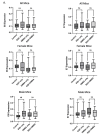Topical Protease Inhibitor Decreases Anal Carcinogenesis in a Transgenic Mouse Model of HPV Anal Disease
- PMID: 37112993
- PMCID: PMC10146494
- DOI: 10.3390/v15041013
Topical Protease Inhibitor Decreases Anal Carcinogenesis in a Transgenic Mouse Model of HPV Anal Disease
Abstract
Anal cancer is a major health problem. This study seeks to determine if the topical protease inhibitor Saquinavir (SQV), is effective at the prevention of anal cancer in transgenic mice with established anal dysplasia. K14E6/E7 mice were entered into the study when the majority spontaneously developed high-grade anal dysplasia. To ensure carcinoma development, a subset of the mice was treated with a topical carcinogen: 7,12-Dimethylbenz[a]anthracene (DMBA). Treatment groups included: no treatment, DMBA only, and topical SQV with/without DMBA. After 20 weeks of treatment, anal tissue was harvested and evaluated histologically. SQV was quantified in the blood and anal tissue, and tissue samples underwent analysis for E6, E7, p53, and pRb. There was minimal systemic absorption of SQV in the sera despite high tissue concentrations. There were no differences in tumor-free survival between SQV-treated and respective control groups but there was a lower grade of histological disease in the mice treated with SQV compared to those untreated. Changes in E6 and E7 levels with SQV treatment suggest that SQV may function independently of E6 and E7. Topical SQV decreased histological disease progression in HPV transgenic mice with or without DMBA treatment without local side effects or significant systemic absorption.
Keywords: HPV; anal cancer; anal dysplasia; chemoprevention; squamous cell carcinoma of the anus.
Conflict of interest statement
The authors declare no conflict of interest.
Figures








Similar articles
-
Topical Protease Inhibitor Increases Tumor-Free and Overall Survival in CD4-Depleted Mouse Model of Anal Cancer.Viruses. 2024 Sep 5;16(9):1421. doi: 10.3390/v16091421. Viruses. 2024. PMID: 39339897 Free PMC article.
-
Dysregulation of Autophagy Contributes to Anal Carcinogenesis.PLoS One. 2016 Oct 5;11(10):e0164273. doi: 10.1371/journal.pone.0164273. eCollection 2016. PLoS One. 2016. PMID: 27706233 Free PMC article.
-
PI3K/mTOR inhibition prevents anal cancer in mice with established low-grade anal dysplasia.Exp Mol Pathol. 2022 Apr;125:104752. doi: 10.1016/j.yexmp.2022.104752. Epub 2022 Feb 18. Exp Mol Pathol. 2022. PMID: 35183509 Free PMC article.
-
Topical application of a dual PI3K/mTOR inhibitor prevents anal carcinogenesis in a human papillomavirus mouse model of anal cancer.Eur J Cancer Prev. 2019 Nov;28(6):483-491. doi: 10.1097/CEJ.0000000000000505. Eur J Cancer Prev. 2019. PMID: 30888976 Free PMC article.
-
HPV DNA, E6/E7 mRNA, and p16INK4a detection in head and neck cancers: a systematic review and meta-analysis.Lancet Oncol. 2014 Nov;15(12):1319-31. doi: 10.1016/S1470-2045(14)70471-1. Epub 2014 Oct 16. Lancet Oncol. 2014. PMID: 25439690
Cited by
-
Special Issue "Efficacy and Safety of Antiviral Therapy".Viruses. 2023 Jun 21;15(7):1411. doi: 10.3390/v15071411. Viruses. 2023. PMID: 37515099 Free PMC article.
-
Topical Protease Inhibitor Increases Tumor-Free and Overall Survival in CD4-Depleted Mouse Model of Anal Cancer.Viruses. 2024 Sep 5;16(9):1421. doi: 10.3390/v16091421. Viruses. 2024. PMID: 39339897 Free PMC article.
References
-
- Cancer of the Anus, Anal Canal, and Anorectum—Cancer Stat Facts. SEER. [(accessed on 9 August 2022)]; Available online: https://seer.cancer.gov/statfacts/html/anus.html.
-
- HPV Vaccination|Cancer Trends Progress Report. [(accessed on 23 December 2022)]; Available online: https://progressreport.cancer.gov/prevention/hpv_immunization.
Publication types
MeSH terms
Substances
Grants and funding
LinkOut - more resources
Full Text Sources
Medical
Research Materials
Miscellaneous

